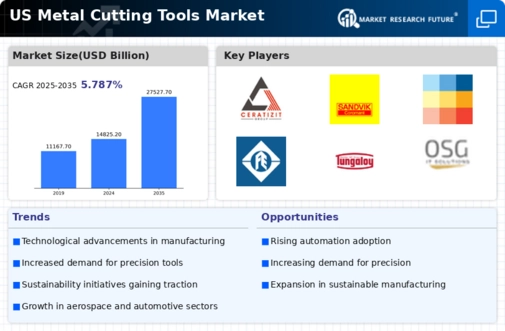Expansion of Aerospace Manufacturing
The aerospace manufacturing sector is experiencing robust growth, which significantly impacts the metal cutting-tools market. With the US aerospace industry projected to reach $1 trillion by 2025, the demand for precision cutting tools is expected to rise correspondingly. Aerospace components require high levels of accuracy and durability, necessitating advanced metal cutting technologies. As manufacturers strive to meet the increasing production rates and complex designs, the metal cutting-tools market is poised for expansion. This growth is further fueled by innovations in materials and manufacturing processes, which necessitate the use of specialized cutting tools to ensure optimal performance and safety in aerospace applications.
Rising Demand from Automotive Sector
The automotive sector is a major driver for the metal cutting-tools market. As the industry continues to evolve, the need for precision-engineered components has surged. In 2025, the automotive industry in the US is projected to grow by approximately 5%, leading to increased demand for high-quality cutting tools. This growth is largely attributed to the shift towards electric vehicles, which require advanced manufacturing techniques. Consequently, manufacturers are investing in state-of-the-art metal cutting tools to enhance productivity and efficiency. The metal cutting-tools market is likely to benefit from this trend, as companies seek to optimize their production processes and meet the stringent quality standards of the automotive sector.
Increased Investment in Infrastructure
The US government has announced substantial investments in infrastructure projects, which is likely to drive demand for the metal cutting-tools market. With a focus on modernizing transportation systems and public facilities, the construction and manufacturing sectors are expected to see a surge in activity. This increased investment is projected to result in a growth rate of around 4% in the construction industry by 2025. As construction companies ramp up their operations, the need for efficient and reliable metal cutting tools becomes paramount. The metal cutting-tools market stands to gain from this trend, as contractors seek to enhance their capabilities and improve project timelines through the use of advanced cutting technologies.
Growing Emphasis on Precision Engineering
Precision engineering is becoming increasingly critical across various industries, driving the demand for specialized metal cutting tools. As sectors such as medical devices, electronics, and defense require components with tight tolerances, the metal cutting-tools market is likely to see a surge in demand for high-precision cutting tools. In 2025, the market for precision-engineered products is expected to grow by approximately 6%, reflecting the rising need for accuracy in manufacturing processes. This trend compels manufacturers to invest in advanced cutting technologies that can deliver the required precision, thereby enhancing the overall quality and performance of their products.
Technological Integration in Manufacturing
The integration of advanced technologies such as automation and Industry 4.0 principles is transforming the manufacturing landscape, thereby influencing the metal cutting-tools market. As manufacturers adopt smart technologies, the demand for high-performance cutting tools that can operate in automated environments is increasing. In 2025, it is anticipated that around 30% of manufacturing processes will be automated, necessitating the use of cutting tools that can withstand higher operational demands. This shift presents opportunities for the metal cutting-tools market to innovate and develop tools that cater to the evolving needs of manufacturers, ensuring efficiency and precision in production.





















Leave a Comment